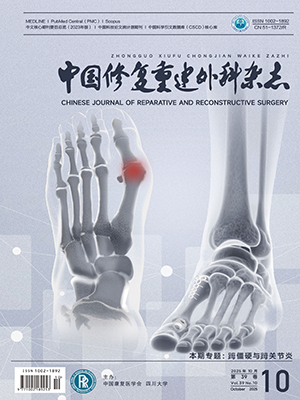| 1. |
Myers TG, Ramkumar PN, Ricciardi BF, et al. Artificial Intelligence and Orthopaedics: An Introduction for Clinicians. J Bone Joint Surg (Am), 2020, 102(9): 830-840.
|
| 2. |
魏航, 陳沁群, 王正飛, 等. 醫工結合背景下數據科學能力培養模式探索. 電腦知識與技術, 2023, 19(8): 68-70.
|
| 3. |
Mutasa S, Varada S, Goel A, et al. Advanced deep learning techniques applied to automated femoral neck fracture detection and classification. J Digit Imaging, 2020, 33(5): 1209-1217.
|
| 4. |
Paix?o GMM, Santos BC, Araujo RM, et al. Machine learning in medicine: review and applicability. Arq Bras Cardiol, 2022, 118(1): 95-102.
|
| 5. |
Kriegeskorte N, Golan T. Neural network models and deep learning. Curr Biol, 2019, 29(7): R231-R236.
|
| 6. |
Park CW, Seo SW, Kang N, et al. Artificial intelligence in health care: current applications and issues. J Korean Med Sci, 2020, 35(42): e379.
|
| 7. |
Dauer E, Goldberg A. What’s new in trauma resuscitation? Adv Surg, 2019, 53: 221-233.
|
| 8. |
Obermeyer Z, Emanuel EJ. Predicting the future—big data, machine learning, and clinical medicine. N Engl J Med, 2016, 375(13): 1216-1219.
|
| 9. |
Deo RC. Machine learning in medicine. Circulation, 2015, 132(20): 1920-1930.
|
| 10. |
Barreto GA, Souza LG. Adaptive filtering with the self-organizing map: a performance comparison. Neural Netw, 2006, 19(6-7): 785-798.
|
| 11. |
Galbusera F, Casaroli G, Bassani T. Artificial intelligence and machine learning in spine research. JOR Spine, 2019, 2(1): e1044.
|
| 12. |
Podgorelec V, Kokol P, Stiglic B, et al. Decision trees: an overview and their use in medicine. J Med Syst, 2002, 26(5): 445-463.
|
| 13. |
Chen T, G Carlos. XGBoost: a Scalable Tree Boosting System//Proceedings of the 22nd ACM SIGKDD International Conference on Knowledge Discovery and Data Mining. San Francisco: ACM SIGKDD, 2016. doi: 10.1145/2939672.2939785.
|
| 14. |
Mavroforakis ME, Theodoridis S. A geometric approach to support vector machine (SVM) classification. IEEE Trans Neural Netw, 2006, 17(3): 671-682.
|
| 15. |
McCulloch WS, Pitts W. A logical calculus of the ideas immanent in nervous activity. Bull Math Biol 1943; 52 (1-2): 99-115.
|
| 16. |
Hinton GE, Osindero S, Teh YW. A fast learning algorithm for deep belief nets. Neural Comput, 2006, 18(7): 1527-1554.
|
| 17. |
Hashimoto DA, Rosman G, Rus D, et al. Artificial intelligence in surgery: promises and perils. Ann Surg, 2018, 268(1): 70-76.
|
| 18. |
Shi L, Wang XC, Wang YS. Artificial neural network models for predicting 1-year mortality in elderly patients with intertrochanteric fractures in China. Braz J Med Biol Res, 2013, 46(11): 993-999.
|
| 19. |
Phung VH, Rhee EJ. A high-accuracy model average ensemble of convolutional neural networks for classification of cloud image patches on small datasets. Applied Sciences, 2019, 9(21): 4500.
|
| 20. |
Borjali A, Chen AF, Muratoglu OK, et al. Deep learning in orthopedics: how do we build trust in the machine? Healthcare Transformation, 2020. https://doi.org/10.1089/heat.2019.0006.
|
| 21. |
Lalehzarian SP, Gowd AK, Liu JN. Machine learning in orthopaedic surgery. World J Orthop, 2021, 12(9): 685-699.
|
| 22. |
Kalmet PHS, Sanduleanu S, Primakov S, et al. Deep learning in fracture detection: a narrative review. Acta Orthop, 2020, 91(2): 215-220.
|
| 23. |
Brett A, Miller CG, Hayes CW, et al. Development of a clinical workflow tool to enhance the detection of vertebral fractures: accuracy and precision evaluation. Spine (Phila Pa 1976), 2009, 34(22): 2437-2443.
|
| 24. |
Krizhevsky A, Sutskever I, Hinton GE. ImageNet classification with deep convolutional neural networks. Communications of the ACM, 2017, 60(6): 84-90.
|
| 25. |
Kim DH, MacKinnon T. Artificial intelligence in fracture detection: transfer learning from deep convolutional neural networks. Clin Radiol, 2018, 73(5): 439-445.
|
| 26. |
Chung SW, Han SS, Lee JW, et al. Automated detection and classification of the proximal humerus fracture by using deep learning algorithm. Acta Orthop, 2018, 89(4): 468-473.
|
| 27. |
Meena T, Roy S. Bone fracture detection using deep supervised learning from radiological images: a paradigm shift. Diagnostics (Basel), 2022, 12(10): 2420.
|
| 28. |
Urakawa T, Tanaka Y, Goto S, et al. Detecting intertrochanteric hip fractures with orthopedist-level accuracy using a deep convolutional neural network. Skeletal Radiol, 2019, 48(2): 239-244.
|
| 29. |
Kitamura G, Chung CY, Moore BE. Ankle fracture detection utilizing a convolutional neural network ensemble implemented with a small sample, de novo training, and multiview incorporation. J Digit Imaging, 2019, 32(4): 672-677.
|
| 30. |
湯小勇, 李曉虎, 谷雪蓮, 等. 基于人工智能的膝關節自動建模研究. 中國修復重建外科雜志, 2023, 37(3): 348-352.
|
| 31. |
Pranata YD, Wang KC, Wang JC, et al. Deep learning and SURF for automated classification and detection of calcaneus fractures in CT images. Comput Methods Programs Biomed, 2019, 171: 27-37.
|
| 32. |
Delmas PD, van de Langerijt L, Watts NB, et al. Underdiagnosis of vertebral fractures is a worldwide problem: the IMPACT study. J Bone Miner Res, 2005, 20(4): 557-563.
|
| 33. |
Tomita N, Cheung YY, Hassanpour S. Deep neural networks for automatic detection of osteoporotic vertebral fractures on CT scans. Comput Biol Med, 2018, 98: 8-15.
|
| 34. |
Muehlematter UJ, Mannil M, Becker AS, et al. Vertebral body insufficiency fractures: detection of vertebrae at risk on standard CT images using texture analysis and machine learning. Eur Radiol, 2019, 29(5): 2207-2217.
|
| 35. |
Dreiseitl S, Ohno-Machado L. Logistic regression and artificial neural network classification models: a methodology review. J Biomed Inform, 2002, 35(5-6): 352-359.
|
| 36. |
Lee NJ, Kothari P, Phan K, et al. Incidence and risk factors for 30-day unplanned readmissions after elective posterior lumbar fusion. Spine (Phila Pa 1976), 2018, 43(1): 41-48.
|
| 37. |
Poduval M, Ghose A, Manchanda S, et al. Artificial intelligence and machine learning: a new disruptive force in orthopaedics. Indian J Orthop, 2020, 54(2): 109-122.
|
| 38. |
Yu KH, Kohane IS. Framing the challenges of artificial intelligence in medicine. BMJ Qual Saf, 2019, 28(3): 238-241.
|
| 39. |
Dennis BM, Stonko DP, Callcut RA, et al. Artificial neural networks can predict trauma volume and acuity regardless of center size and geography: A multicenter study. J Trauma Acute Care Surg, 2019, 87(1): 181-187.
|
| 40. |
Stonko DP, Dennis BM, Betzold RD, et al. Artificial intelligence can predict daily trauma volume and average acuity. J Trauma Acute Care Surg, 2018, 85(2): 393-397.
|
| 41. |
Kong SH, Ahn D, Kim BR, et al. A novel fracture prediction model using machine learning in a community-based cohort. JBMR Plus, 2020, 4(3): e10337.
|
| 42. |
Forth KE, Wirfel KL, Adams SD, et al. A postural assessment utilizing machine learning prospectively identifies older adults at a high risk of falling. Front Med (Lausanne), 2020, 7: 591517.
|
| 43. |
Zhang T, Nikouline A, Lightfoot D, et al. Machine learning in the prediction of trauma outcomes: a systematic review. Ann Emerg Med, 2022, 80(5): 440-455.
|
| 44. |
Liu NT, Holcomb JB, Wade CE, et al. Development and validation of a machine learning algorithm and hybrid system to predict the need for life-saving interventions in trauma patients. Med Biol Eng Comput, 2014, 52(2): 193-203.
|
| 45. |
Cardosi JD, Shen H, Groner JI, et al. Machine learning for outcome predictions of patients with trauma during emergency department care. BMJ Health Care Inform, 2021, 28(1): e100407.
|
| 46. |
Lee KC, Hsu CC, Lin TC, et al. Prediction of prognosis in patients with trauma by using machine learning. Medicina (Kaunas), 2022, 58(10): 1379.
|
| 47. |
Zhao H, You J, Peng Y, et al. Machine learning algorithm using electronic chart-derived data to predict delirium after elderly hip fracture surgeries: a retrospective case-control study. Front Surg, 2021, 8: 634629.
|
| 48. |
Li YY, Wang JJ, Huang SH, et al. Implementation of a machine learning application in preoperative risk assessment for hip repair surgery. BMC Anesthesiol, 2022, 22(1): 116.
|
| 49. |
Klemt C, Cohen-Levy WB, Robinson MG, et al. Can machine learning models predict failure of revision total hip arthroplasty? Arch Orthop Trauma Surg, 2023, 143(6): 2805-2812.
|
| 50. |
DeBaun MR, Chavez G, Fithian A, et al. Artificial neural networks predict 30-day mortality after hip fracture: insights from machine learning. J Am Acad Orthop Surg, 2021, 29(22): 977-983.
|
| 51. |
Forssten MP, Bass GA, Ismail AM, et al. Predicting 1-year mortality after hip fracture surgery: an evaluation of multiple machine learning approaches. J Pers Med, 2021, 11(8): 727.
|
| 52. |
Hendrickx LAM, Sobol GL, Langerhuizen DWG, et al. A machine learning algorithm to predict the probability of (Occult) posterior malleolar fractures associated with tibial shaft fractures to guide “malleolus first” fixation. J Orthop Trauma, 2020, 34(3): 131-138.
|
| 53. |
Kruse C, Eiken P, Vestergaard P. Machine learning principles can improve hip fracture prediction. Calcif Tissue Int, 2017, 100(4): 348-360.
|
| 54. |
Oosterhoff JHF, Doornberg JN. Artificial intelligence in orthopaedics: false hope or not? A narrative review along the line of Gartner’s hype cycle. EFORT Open Rev, 2020, 5(10): 593-603.
|
| 55. |
Chernew ME, Landrum MB. Targeted supplemental data collection—addressing the quality-measurement conundrum. N Engl J Med, 2018, 378(11): 979-981.
|
| 56. |
Bartram L, Correll M, Tory M. Untidy data: the unreasonable effectiveness of tables. IEEE Trans Vis Comput Graph, 2022, 28(1): 686-696.
|
| 57. |
Stonko DP, Guillamondegui OD, Fischer PE, et al. Artificial intelligence in trauma systems. Surgery, 2021, 169(6): 1295-1299.
|
| 58. |
Dooley JH, Ozdenerol E, Sharpe JP, et al. Location, location, location: Utilizing Needs-Based Assessment of Trauma Systems-2 in trauma system planning. J Trauma Acute Care Surg, 2020, 88(1): 94-100.
|
| 59. |
米爾阿地力·麥麥提依明, 依力哈木江·吾斯曼, 孫榮鑫, 等. 人工智能術前規劃系統在人工全髖關節置換術治療成人發育性髖關節發育不良中的應用研究. 中國修復重建外科雜志, 2023, 37(1): 25-30.
|
| 60. |
Kamer L, Noser H, Arand C, et al. Artificial intelligence and CT-based 3D statistical modeling to assess transsacral corridors and plan implant positioning. J Orthop Res, 2021, 39(12): 2681-2692.
|
| 61. |
殷耀斌, 王志新, 伊喆, 等. 天璣骨科機器人輔助四角融合經皮螺釘內固定技術介紹. 中國修復重建外科雜志, 2023, 37(6): 764-766.
|
| 62. |
賈鵬, 吳新寶. 骨科機器人輔助手術在創傷骨科的臨床應用現狀與發展. 中華創傷骨科雜志, 2023, 25(5): 433-439.
|
| 63. |
Santilli V, Mangone M, Diko A, et al. The use of machine learning for inferencing the effectiveness of a rehabilitation program for orthopedic and neurological patients. Int J Environ Res Public Health, 2023, 20(8): 5575.
|




